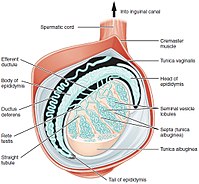
Photo from wikipedia
Abstract Testis size determination is an important question of reproductive biology. Sertoli cells are known to be a key determinant of mammalian testis size but the underlying molecular mechanisms remain… Click to show full abstract
Abstract Testis size determination is an important question of reproductive biology. Sertoli cells are known to be a key determinant of mammalian testis size but the underlying molecular mechanisms remain incompletely understood. Previously we showed that highly conserved germ cell RNA-binding proteins, PUMILIO1(PUM1) and PUMILIO2 (PUM2), control mouse organ and body size through translational regulation, but how different cell types of the organs contribute to their organ size regulation has not been established. Here, we report a somatic role of PUM in gonad size determination. PUM1 is highly expressed in the Sertoli cells of the developing testis from embryonic and postnatal mice as well as in germ cells. Removal of Sertoli cell, but not germ cell, Pum1 gene, led to reduced testis size without significantly affecting sperm number or fertility. Knockout of PUM1 target, Cdkn1b, rescued the phenotype of reduced testis size, supporting a key role of Sertoli cell PUM1 mediated Cdkn1b repression in the testis size control. Furthermore, removal of Pum2 or both Pum1 and Pum2 in the Sertoli cells also only affected the testis size, not sperm development, with the biggest size reduction in Pum1/2 double knockout mice. We propose that PUM1 and PUM2 modulate the testis size through their synergistic translational regulation of cell cycle regulators in the Sertoli cell. Further investigation of the ovary or other organs could reveal if PUM-mediated translational control of cell proliferation of the supporting cell represents a general mechanism for organ size modulation. Summary Sentence PUM1 and PUM2 modulate mouse testis size through their synergistic translational regulation of cell cycle regulators in Sertoli cells. Graphical Abstract
Journal Title: Biology of Reproduction
Year Published: 2022
Link to full text (if available)
Share on Social Media: Sign Up to like & get
recommendations!